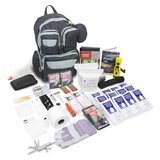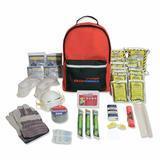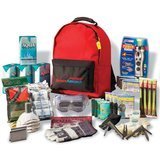It is still Earthquake Preparedness Week. Be sure you are Prepared for Earthquakes, as well as any other disaster that might come your way. Prepare as best you can. Then Pray. And then STAND. Below you will find some very helpful information.
DISCLAIMER: In my posts I normally collect a number of written articles and videos related to the topic. I hightlight in red or black the parts of the articles that I think are important to note and try to leave it to the reader to come to their own conclusions. The object is to bring the facts/truths to your attention and cause you to look further into them yourself. Why? Because that is the only way to make the subject real to you. When you view the available information, search it our on your own, hopefully guided by the Holy Spirit, YOUR CONCLUSION is exactly that YOURS. It means something to you. It may be similar to mine or it may be completely different. We are all on our own course and in different places with our spiritual development. I pray that GOD speaks to you in a way that touches you. IF you see notes in green, those are my comments. Anything else, you find the source links on the titles, and the author and date will be below the titles. Just because I post an article or video in my articles, it does not mean that I agree with the author or support their stand. It does mean that I felt there was worthwhile information to be gleaned.
10-15-20 Quake News & Updates
JCrisp@tctelco.net
10:00 p.m.
Interestingly, it is National Earthquake Preparedness week in the U.S. and today was the “Great Shake Out” series of earthquake drills happening in several parts of the country. For more information, see the Links & Resources section in tonight’ update.
PREP TIPS:
Interestingly, this is national Earthquake Preparedness week, with multiple “Great Shake-Out” earthquake drills happening today in different parts of the country, including in the New Madrid region. It is time to check your emergency packs to make sure you have everything you need. Remind your family to keep them accessible – easy to grab on their way out of the house. Make sure all your flashlights have fresh batteries. After supper tonight, suddenly tell all the family members to get your packs and meet at the front door ASAP and time them on how quickly they can get there with their emergency packs. If you want to make it more interesting, flip the breakers for the lights and have them do it in the dark. Everyone should have their shoes on, with packs and water bottles ready to go. Evaluate the performance.
Discuss the importance of disaster preparedness. Help everyone get their stuff! These kinds of family home drills should be happening every 2-3 months, and more often in the current situation, and manifesting good attitudes from all.There are some updates about the New Madrid quake threat in tonight’s update, so be sure to read those. If a big quake strikes the region, most of you won’t have to ask me when it struck, because most of you will feel it shake hard!
Summary: Overall, worldwide earthquake and volcanic activity is LOW right now.
It is the “calm before the storm,” when seismic activity picks up in a major way in the
next week. Another forecast is now complete with 100% accuracy on 65 regions.
The New Madrid continues to manifest hot spots. Just so you don’t think every heat
signature is a wildfire, you should know that we see these kinds of hot spot temperatures
(800-1000+ degree Fahrenheit) out in the ocean – along faults and undersea mounts
(volcanoes) occasionally. Much of Missouri is now under a red flag burn ban, so these
are NOT farm field burn-offs. Hot spots were also seen in southern Illinois and NE
Arkansas yesterday. Today, cloud cover is preventing us from seeing them easily.WATCHES & WARNINGS: imminent threats for large earthquakes or tsunamis
• The WARNING remains in effect for a large earthquake with a top-end potential in
the M5.4-6.6 (6.9) range to strike off the coast of the Pacific Northwest, along the
Juan de Fuca fracture zone, most likely off the coast of southern Oregon in the next
3-5 days. If this forecasted quake strikes as expected, California should be on
ALERT for multiple M5.0+ range quakes in central and southern parts of the state occurring within a few days. I will update the forecast when it strikes.
• A WARNING remains in effect for SE Missouri/NE Arkansas/West Tennessee, in the New Madrid seismic zone for a possible large quake with a high-end potential in the M4.9-7.9 (8.2) range in the next 6 days (by Oct. 21). A swarm in NE
Arkansas continues which may precede a larger event. Additional small quakes
have struck in NW Tennessee.Attached is the current issue of the Quake News & Updates.
Stay safe!
The Watchman
spacer

Preparedness
The to workers result from: being struck by structural components or furnishings, inadequately secured stored materials, burns resulting from building fires resulting from gas leaks or electrical shorts, or exposure to chemicals released from stored or process chemicals. Many of the hazards to workers both during and following an earthquake are predictable and may be reduced through hazard identification, planning, and mitigation.
There are many things you can do to prepare your workplace before an earthquake occurs:
- Pick “safe places”. A safe place could be under a sturdy table or desk or against an interior wall away from windows, bookcases or tall furniture that could fall on you. The shorter the distance to move to safety, the less likely that you will be injured. Injury statistics show that people moving as little as ten feet during an earthquake’s shaking are most likely to be injured.
- Practice drop, cover, and hold-on in each safe place. Drop under a sturdy desk or table and hold on to one leg of the table or desk. Protect your eyes by keeping your head down. Practice these actions so that they become an automatic response.
- Practice these safe earthquake procedures (i.e., drop, cover, and hold-on) at least twice a year. Frequent practice will help reinforce safe behavior. When an earthquake or other disaster occurs, many people hesitate, trying to remember what they are supposed to do. Responding quickly and automatically may help protect you from injury.
- Make a plan for workers to follow in the event of an earthquake and be sure that it includes the following precautions:
What are aftershocks?
Aftershocks are smaller earthquakes that follow the main shock and can cause further damage to weakened buildings. After-shocks can occur in the first hours, days, weeks, or even months after the quake. Be aware that some earthquakes are actually foreshocks, and a larger earthquake might occur.
- Wait in your safe place until the shaking stops, then check to see if you are hurt. You will be better able to help others if you take care of yourself first, and then check the people around you. Move carefully and watch out for things that have fallen or broken, creating hazards. Be ready for aftershocks.
- Be on the lookout for fires. Fire is the most common earthquake-related hazard, due to broken gas lines, damaged electrical lines or appliances, and previously contained fires or sparks being released.
- If you must leave a building after the shaking stops, use the stairs, not the elevator, and look for falling debris. Earthquakes can cause fire alarms and fire sprinklers to go off. You will not be able to rule out whether there is a real threat of fire, and the elevators may have been compromised. Always use the stairs.
- If you’re outside in an earthquake, stay outside. Move away from buildings, trees, streetlights and overhead lines. Crouch down and cover your head. Many injuries occur within ten feet of the entrance to buildings. Bricks, roofing and other materials can fall from buildings, injuring persons nearby. Trees, streetlights and overhead lines may also fall, causing damage or injury.
- Inform workers of the plan and discuss earthquakes with workers. Everyone in your workplace should know what to do if an earthquake occurs. Discussing earthquakes ahead of time helps reduce fear and anxiety and lets everyone know how to respond.
- Get training. Take a first-aid class from an organization such as the American Red Cross, American Heart Association, or National Safety Council chapter. Get training on how to use a fire extinguisher. Keep your training current. Training will help you to keep focused and know what to do when an earthquake occurs.
- Businesses can use the Federal Emergency Management Agency How to Series for protecting people/property during emergencies. Perform a workplace survey, especially if you are in an area with a high risk of earthquakes, to identify potential hazards to workers if an earthquake occurs. Look for furniture or materials that could fall and strike workers or block means of egress, or cause a release of hazardous materials, or otherwise affect the health and safety of workers as a result of utility loss or system/structural failure. Follow mitigation techniques recommended by FEMA for equipment and furniture.
Employers whose workers will be involved in emergency response operations for releases of, or substantial threats of releases of, hazardous substances regardless of the location of the hazard must comply with OSHA’s Hazardous Waste Operations and Emergency Response (HAZWOPER) standard, 29 CFR 1910.120. This may include emergency response following an earthquake. Instruction CPL 02-02-073 describes OSHA enforcement procedures under the relevant provisions of the HAZWOPER standard.
The U.S. Environmental Protection Agency (EPA) has promulgated a standard applying OSHA’s HAZWOPER standard to state and local government workers in states where there is no OSHA-approved State Plan. See 40 CFR Part 311.
OSHA’s HAZWOPER Safety and Health Topics page explains requirements of the OSHA HAZWOPER standard, including required worker training.
Equipping
Get emergency supply kits and keep them in shelter locations.
- Basic Disaster Supplies Kit. Ready.gov – Federal Emergency Management Agency (FEMA). Lists supplies needed for a disaster kit.
- Workplace Plans. Ready.gov – Federal Emergency Management Agency (FEMA). Provides basic information on developing an emergency management plan for the workplace.
- Emergency Supplies for Earthquake Preparedness. Centers for Disease Control and Prevention. (CDC). Lists supplies needed for an earthquake preparedness kit.
Training and Exercises
- Ensure that all workers know what to do in case of an earthquake.
- Practice earthquake and evacuation plans on a regular basis.
- Update plans and procedures based on lessons learned from exercises.
OSHA’s Disaster Site Worker Outreach Training Program is a training program for workers who provide skilled support services (e.g., utility, demolition, debris removal, or heavy equipment operation) or site clean-up services. The program highlights the differences between disaster sites and construction sites, and emphasizes the need for workers and employers to have pre-incident training.
ShakeOut is an annual global earthquake drill supported by FEMA, the U.S. Geological Society (USGS), the National Science Foundation, and others. Businesses and other organizations can register and participate for free. ShakeOut provides an earthquake Drill Manual for Businesses with lessons for workers and employers.
Develop an Emergency Action Plan
A disorganized evacuation can result in confusion, injury and property damage. An emergency action plan is critical. An emergency action plan checklist can assist this process.
When to evacuate:
- If emergency response authorities indicate specifically to do so.
- If emergency response authorities indicate there is time to do so.
- If you can reach a safe location before an event is expected to occur.
- When environmental conditions would not expose evacuees to a dangerous environment.
Evacuation plans should include:
- Conditions under which evacuation would be necessary (considering the above information);
- When sheltering in place may be a better alternative;
- A clear chain of command and designation of the person in workplace authorized to order an evacuation;
- Specific evacuation procedures, including routes and exits;
- Specific procedures for employers and workers in high-rise buildings (if applicable);
- Procedures for assisting visitors and workers in evacuating, particularly those with disabilities or who do not speak English;
- Designation of which, if any, workers will remain after an evacuation alarm to shutdown critical operations or perform other duties before evacuating; and
- Special equipment for workers, including personal protective equipment and respiratory protection (e.g., escape respirators), if needed.
National Seismic Hazard Map
USGS updated their U.S. National Seismic Hazard Maps, which reflect the best and most current understanding of where future earthquakes will occur, how often they will occur, and how hard the ground will likely shake as a result. All states have some potential for earthquakes, 42 of the 50 states have a reasonable chance of experiencing damaging ground shaking from an earthquake in 50 years. The hazard is especially high along the west coast, intermountain west, and in several active regions of the central and eastern U.S., such as near New Madrid, MO, and near Charleston, SC. The 16 states at highest risk are AK, AR, CA, HI, ID, IL, KY, MO, MT, NV, OR, SC, TN, UT, WA, and WY.
2014 USGS National Seismic Hazard Map, displaying intensity of potential ground shaking from an earthquake in 50 years (which is the typical lifetime of a building).
Additional Resources
- Earthquake Publications: Private Sector & Small Businesses. Federal Emergency Management Agency (FEMA). Lists FEMA publications that are useful to businesses in developing a workplace program for earthquake preparedness.
- Being Prepared for an Earthquake. Centers for Disease Control and Prevention (CDC). Discusses what to do before, during and after an earthquake. Provides advice on developing evacuation plans and gathering emergency supplies.
- Earthquake Terms and Concepts. U.S. Geological Survey (USGS)
- The U.S. Department of Homeland Security (DHS), Federal Emergency Management Agency’s (FEMA) Ready.gov site provides additional information about worksite emergency preparedness programs.
- The Red Cross Ready Rating Program also provides information for evaluating your workplace’s level of preparedness in advance of an emergency.
The State of Alaska
The Alaska Division of Homeland Security and Emergency Management has an Earthquake website with the following resources:
- Earthquake: Drop Cover & Hold Drill
- Emergency Supplies Checklist
- Preparing Your Family
- Tips for Preparing Children
- Tips for the Physically Challenged
- Tips for the Elderly
- Tips for Apartment and Mobile Home Managers
- Organizing Your Neighborhood
- Tips for Pet Owners
- How to Secure Your Furniture
- How to Strap Your Water Heater
The State of California
Earthquakes can occur anywhere in California, which means all Californians live with an earthquake risk. In addition to the shaking caused by earthquakes, other things can occur such as landslides, surface fault ruptures and liquefaction–all of which may cause injury or property damage. Some areas within California are also vulnerable to tsunamis should an earthquake occur. The California Governor’s Office of Emergency Services has emergency preparedness and response resources.
The state of California also has a Department of Conservation that provides services and information that promote environmental health, economic vitality, informed land-use decisions, and sound management of the state’s natural resources. Specifically, the California Geological Survey (CSG) has an earthquake website which includes various tools such as ShakeMaps (which are a representation of ground shaking produced by an earthquake), probability calculators, shaking hazards, and hazard zones.
The State of Oregon
Oregon is considered a high-risk state for earthquakes. In the last 130 years, the state has experienced several earthquakes over magnitude 5. The Oregon Office of Emergency Management’s Earthquake website has various preparedness resources posted including an earthquake evacuation checklist, information on Oregon Shakeout (which is an earthquake drill), training videos, and other publications and presentations.
In January 2004, Oregon published an Earthquake Preparedness and Mitigation Guidance for Oregon State Agency Offices and Warehouses. This document focuses on (1) what to do during an earthquake in office and warehouse settings and (2) what to do before an earthquake that will reduce casualties and non-structural damage during the earthquake. The report is for guidance only. Recommendations to create safe work environments are not requirements, except for those building code and other safety requirements that are specifically identified in the document.
To view earthquake preparedness and response for your State or Territory, please visit
U.S. Earthquake Information by State/Territory USGS
Magnitude vs. Ground Motion and Energy
Magnitude Change Ground Motion Change (Displacement) Energy Change 1.0 10.0 times about 32 times 0.5 3.2 times about 5.5 times 0.3 2.0 times about 3 times 0.1 1.3 times about 1.4 times This table shows that a magnitude 7.2 earthquake produces 10 times more ground motion than a magnitude 6.2 earthquake, but it releases about 32 times more energy. The Energy Change best indicates the destructive power of an earthquake. (USGS)
As an example, the Great Alaska Earthquake of 1964 was a 9.2 magnitude quake while the recent earthquake in Chili (4-1-2014) was an 8.2 magnitude quake. The change in magnitude of 1.0 is seen in the effects as both quakes caused Tsunamis. However the 8.2 quake caused a six foot tsunami while the 9.2 quake is said to have caused 12 to 21 foot waves from Alaska to California.
spacer
Governor Henry McMaster has proclaimed Earthquake Preparedness Week for 2020 to be observed October 11-17 in South Carolina. The S.C. Emergency Management Division encourages everyone to take this opportunity to learn about our state’s seismic fault system and how best to prepare for earthquakes. A highlight of the week will be the Great Southeast ShakeOut on Thursday, October 15 at 10:15 a.m.
More than one million people across eight states and Washington D.C. will take part in the Great SouthEast ShakeOut earthquake safety drill. The regional ShakeOut drill is part of an international effort in which participants simultaneously practice how to stay safe during an earthquake — “Drop, Cover, and Hold On”. For most people, in most situations, this means to:
- DROP where you are, onto your hands and knees;
- COVER your head and neck with one arm and hand, as you crawl for shelter under a nearby table or desk;
- HOLD ON to your shelter with one hand until shaking stops (remain on your knees and covering your head and neck with your other arm and hand).
While COVID-19 has brought many uncertainties and challenges, you can hold your drill when and where you want. You can choose another date or several dates, and include people in multiple locations (home, work, or school), perhaps through video conferencing.
Schools, businesses, organizations, government agencies, communities, and households are all encouraged to participate. Worldwide, 12 million people are currently expected to participate in Great ShakeOut Earthquake Drills next Thursday. Although the primary activity of the ShakeOut is based upon a drill procedure similar to a fire or tornado drill, participants are encouraged to take actions to become better prepared for all disasters. This could include:
- Securing heavy items to prevent them from causing injuries during an earthquake
- Creating an emergency plan and/or updating emergency supply kits
- Talking with their families and neighbors about emergency preparedness
Registration on the Great Southeast ShakeOut site is an important part of this event. This event is open to everyone in South Carolina. To register, go to www.shakeout.org/southeast.
Similar to other emergency preparedness drills sponsored by SCEMD, the signal to begin the drill will be broadcast next Thursday at 10:15 a.m. on NOAA tone-alert weather radio and broadcast media. All media are encouraged to participate in the ShakeOut by broadcasting the drill message issued by SCEMD and the National Weather Service.
There have been eight low-magnitude earthquakes recorded in South Carolina so far this year. Our state experiences approximately 10 to 20 earthquakes a year according to geologists with the College of Charleston. The South Carolina Emergency Manager mobile app has an earthquake map feature that lists recent earthquake activity. It also allows you to sign up to be notified when an earthquake occurs.
The epicenter of the largest earthquake ever recorded along the eastern United States seaboard was just outside of Charleston on August 31, 1886. The 7.3 magnitude quake devastated the region and was felt from Chicago to Cuba. According to a study commissioned by SCEMD, an earthquake of similar magnitude occurring today would result in tremendous loss of life, severe property damage and extreme economic loss.Click here for your free South Carolina Earthquake Guide.

spacer

| Release Date | Release Number |
|---|---|
| R3-20-NR-038 |
PHILADELPHIA – The annual Great ShakeOut earthquake drill will take place Oct. 15 across the United States and the Federal Emergency Management Agency (FEMA) Region 3 office wants to encourage the Whole Community to participate and learn the simple but critical safety steps to preparing for and staying safe during an earthquake. The Great ShakeOut is the largest earthquake drill worldwide and over 11 million people are already registered to practice their earthquake safety plans.
We encourage everyone to Drop, Cover, and Hold On with us at 10:15 AM Eastern on Oct. 15.
Earthquakes are normally thought of as a west coast hazard, but they can happen anywhere, such as the 2011 earthquake in Virginia. Worldwide there is an average of one damaging earthquake almost every third day.
“Damaging earthquakes can occur at any time – where we work, live or travel,” stated FEMA Region 3 Regional Administrator MaryAnn Tierney. “To be best prepared to respond quickly, we must practice earthquake safety on a regular basis. The Great ShakeOut provides an excellent opportunity to practice our earthquake preparedness skills together.”
While COVID-19 will make this year’s ShakeOut look different, we still encourage you to participate at home or socially distanced.
To help people to prepare and participate, FEMA Region 3 produced a white board video highlighting the steps to practice for the Great ShakeOut. The Great ShakeOut also produces additional videos that address how to protect yourself from earthquakes in a number of scenarios – whether an earthquake strikes while you are in your home, car, bed or elsewhere.
The Great ShakeOut is set for Thursday, Oct. 15, 2020 at 10:15 AM Eastern. During the self-led drill, participants practice how to “Drop, Cover and Hold On.” For most
people, in most situations, the recommended earthquake safety action is to:
- DROP where you are, onto your hands and knees;
- COVER your head and neck with one arm and hand, as you crawl for shelter under a nearby table or desk;
- HOLD ON to your shelter with one hand until shaking stops (remain on your knees and covering your head and neck with your other arm and hand).
The Great ShakeOut is free and open to the public. Participants include individuals, schools, businesses, local and state government agencies, and many other groups. To take part in the ShakeOut, register to participate at www.shakeout.org. Once registered, you’ll receive regular information on how to plan your drill and become better prepared for earthquakes and other disasters.
Hundreds of thousands of people will participate in this event in Pennsylvania, Delaware, Maryland, Virginia, West Virginia, and the District of Columbia, joining Great ShakeOut Earthquake Drills occurring throughout the nation and in several countries. More than 11 million people around the globe are expected to participate. In addition to safety drills, many participants take extra steps to become more prepared for earthquakes or other disasters.
The Great ShakeOut is nationally sponsored by the United States Geological Survey, FEMA, and the National Science Foundation and is supported by dozens of other partners. The Great ShakeOut is coordinated globally by the Southern California Earthquake Center.
For more information, please visit www.shakeout.org. For additional earthquake information, please visit https://www.ready.gov/earthquakes.
Last updated October 13, 2020
spacer
spacer



































